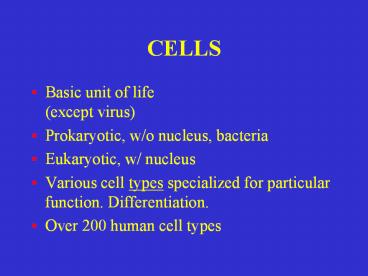CELLS - PowerPoint PPT Presentation
Title:
CELLS
Description:
CELLS Basic unit of life (except virus) Prokaryotic, w/o nucleus, bacteria Eukaryotic, w/ nucleus Various cell types specialized for particular function. – PowerPoint PPT presentation
Number of Views:127
Avg rating:3.0/5.0
Title: CELLS
1
CELLS
- Basic unit of life (except virus)
- Prokaryotic, w/o nucleus, bacteria
- Eukaryotic, w/ nucleus
- Various cell types specialized for particular
function. Differentiation. - Over 200 human cell types
2
(No Transcript)
3
Cells
- 56 of body is fluid
- Similar to sea water
- Intracellular extracellular
- Exchange regulated by cell membrane (plasma
membrane) - Passive transport (with gradient)
- Active transport (requires energy)
4
Cells
- Cell life supported by extracellular fluid
containingIons Calcium, Potassium, Sodium,
Nutrients Glucose, Oxygen, Amino Acids,
Vitamins, ...Regulatory chemicals Steroids,
Hormones, Paracrin/Autocrin factors, ...
5
Biochemistry
Monomer Nucleic Acid Amino Acid Fatty Acid Sugar
Polymer RNA, DNA Peptide, Protein Lipid Polysaccha
ride, Carbohydrate
Genes Gene products Not coded by genes
6
Biochemistry
- Molecules or molecular regions (domains) are
hydrophilic/hydrophobic - Water is polar ( and - charged sides)
- Charged and polar molecules are soluble in water
- Nonionic, nonpolar molecules are insoluble in
water
7
Fig 1
8
Biochemistry
- C-C and C-H (hydrocarbons) bonds are nonpolar
hydrophobic - In water, hydrophobic molecules and nonpolar
regions of molecules aggregate to hide from
water
9
Biochemistry
Amino Acid
H
O
C
H2N
C
OH
Carboxyl
Amino
R
Side Chain (20)
10
Biochemistry
Biochemistry
H
O
H
O
C
H2N
C
OH
C
H2N
C
OH
R
R
H2O
H
O
H
O
H
C
H2N
C
C
N
C
OH
Amino endN-Terminus
Carboxyl end C-Terminus
R
R
11
Biochemistry
- Enzymes - Catalyze reactions (not metabolized).
- All enzymes are proteins, but not all protein are
enzymes. - Structural proteins provide physical rather
than chemical function.
12
Cells
- Cellular substructures called organelles made
from membranes with similar structure floating in
cytoplasm - Membranes consist of bi-layer of phospholipid.
13
Membranes
Phosphate rich protein head Charged - hydrophilic
Lipid tail Hydrophobic
14
(No Transcript)
15
Membranes
- 2D Fluid, oil slick
- Semipermeable depending on size charge
- Suspended proteins float in membranes.
Hydrophobic regions w/in membrane, hydrophilic
regions exposed - Ion channels, pumps, transporters, exchangers,
receptors
16
(No Transcript)
17
(No Transcript)
18
(No Transcript)
19
Organelles
- Endoplasmic Reticulum, smooth rough
- SER - Site of lipid metabolism
- RER - Contiguous with outer nuclear membrane.
Site of protein synthesis (translation), storage,
post-translational modification, sorting, and
transport. Many tubular and vesicular membranes.
20
Organelles
- Ribosomes - Contained in RER
- Responsible for translation of mRNA into protein.
- Made up of protein and specialized structural RNA
called ribosomal RNA (rRNA)
21
Organelles
- Golgi Complex - Specialized portion of RER.
Storage and sorting of protein vesicles prior to
transport to membrane secretion.
22
Organelles
- Mitochondria - Engines of the cell. Convert
glucose to ATP. Number in the hundreds to
thousands. Contain own DNA.
23
Organelles
- Lysosome - Lytic enzymes breakdown organic
compounds and are sequestered lysosomes from rest
of cell for protection. Proteins ? Amino
AcidsCarbohydrates ? Sugars
24
Cytoskeleton
- Give cell structure, motility, intracellular
vesicular trafficking, and ability to replicate. - Microfiliments 7-9nm
- Intermediate filiments 10nm
- Microtubules 24nm
25
Cytoskeleton
Monomer Role Motor MF Actin Stiffen plasma
membrane Myosin Provides motility
by depolymerizing A-M interaction IF V
imentin Strictly structural None Keratins One
end attached membrane Others Integrates cells
w/ other cells and into tissues MT Tubulin
Track for vesicle transport Dynein Cilia and
flagella motion Kinesin Alignment/separation
of chromosomes
26
(No Transcript)
27
(No Transcript)
28
Organelles
- Nucleus - Repository of DNA. Site of RNA
synthesis (translation). Double membrane, outer
continuous with RER. Large channels for export of
mRNA to cytoplasm. Nuclear matrix proteins give
nucleus structure. - Nucleolus - Large nuclear organelle where rRNA is
synthesized and coupled with protein to form
partial ribosomes.
29
(No Transcript)
30
(No Transcript)
31
Protein Synthesis
- RNA polymerase bind to gene promoter and converts
DNA to complementary mRNA (transcription).
Binding to promoter regulated by transcription
factors. - Non-coding mRNA is cleaved. Alternative splicing.
Export of mature mRNA to ER - Ribosome converts mRNA sequence to AA sequence by
attaching tRNAAA subunits in groups of three
mRNA bases (codons).
32
Protein Synthesis
- Multiple ribosomes may be translating each mRNA
over time or simultaneously - This cannot occur for rRNA, so 80-90 of DNA
codes for rRNA. - Post-translational modification - addition of
lipids carbohydrates, assembly of subunits.
Intracellular and extracellular.
33
Translation
AA
tRNA
AA
AA
AA
AA
C
U
A
G
C
T
G
U
A
G
A
C
C
G
U
C
A
U
C
U
G
G
A
U
mRNA
Ribosome (rRNAProtein)
ER
Transcription
Nucleus
Export
RNA Polymerase
mRNA
C
G
U
C
A
U
C
U
G
G
A
G
C
A
G
T
A
G
A
C
C
T
G
G
G
G
C
DNA































